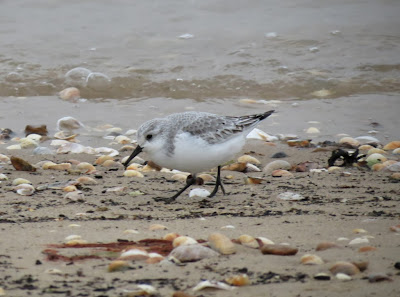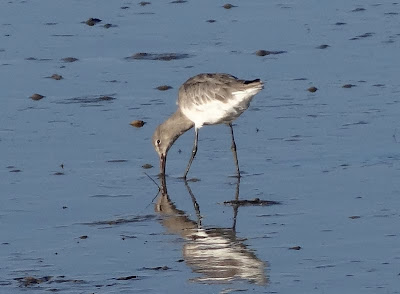The small flock of
sanderling were busy scampering along the water's edge of the river Colne at East Mersea Point on Sunday 3rd. Forty-two birds were noted today with a handful of
turnstones as well. A similar amount were also on the Point yesterday during the late morning high tide.
Only after close scrutiny later on of some of the ten pictures taken of the
sanderling, did I notice this one bird with these green and yellow rings clearly visible. At the time I hadn't realised any of the birds had coloured-rings on because their legs were moving so fast along the beach.
A quick glance on the internet suggests the International Wader Group based in the Netherlands have been colour ringing
sanderling although most of those birds have a tiny flag attached to a ring. I shall make some enquiries and report back and find out where this little fellow has been!
A couple of
oystercatchers were also resting on the beach in the morning before many of the walkers and dogs had got to the area.
There was the pleasant surprise of the
snow bunting seen back on the beach on Saturday and still present on Sunday. After an absence of nearly two weeks, the bird was back on the same bit of strandline, tucked up against the little sandy cliff. It seemed more settled on Sunday than the previous day when it circled round and round and seemed unsure whether to land back down. I believe there was a report earlier today of another two
snow buntings seen on the opposite side of the Colne.
There was more activity on Saturday noted at the Point with
rock pipit, 5
reed buntings, 20
linnets and
pied wagtail. A
common seal was the only thing of interest in the river.
Wigeon, teal and a few
little egrets were feeding on the flooded saltmarsh at high tide. Waders roosting nearby included 50
bar-tailed godwit, 1000
dunlin, 100
knot and 50
grey plover.
A flock of 300
golden plover dropped down to roost in the fields during the Sunday morning high tide. In the afternoon the flock had swollen to 700+ birds and were resting on the mudflats.
Whilst looking at the
plovers, wigeon and
brent geese in the fields a lone
swallow was watched circling around the area, occasionally landing briefly on the grass a few times. There's usually one November sighting most years at the park of a late swallow, so maybe this will be the last seen here this year.
Other small birds flying about the fields were ten
goldfinches, six
meadow pipits and ten
skylarks.
This
greylag goose looked like it was doing some yoga stretches! Not as many greylags in the fields as a fortnight ago with only 20 birds noted today. Also 300
brent geese were in the fields, 700
wigeon and 500
teal.
Still the impressive roost of 1000
black-tailed godwits on the pools in the fields along with 300+
redshank, 80
curlew, 50
lapwing and ten
snipe. There were 21
little egrets in the nearby tree joined by the
grey heron for the first time here. A dozen
stock doves were noted in the fields.
Duck numbers on the pond in the last couple of days have seen 80
mallard, 24
shoveler, 6
gadwall and 3
tufted ducks.
A male
sparrowhawk perched in a tree beside the pond on Saturday being mobbed by a
crow. Four
sparrowhawks were seen on Friday morning with two birds over the car park first thing and then two others flying west over the saltmarsh at the Point.
A
chiffchaff called from the hedge behind the back of the pond on Saturday, two
redpolls flew west over the park on Friday and a
brambling was with ten
chaffinches near the car park on Thursday.
There's been a bumper crop of
apples on some of the wild trees at the park this autumn. A lot of apples were blown off the trees during the strong wind last Monday.
Only managed the one mothing night on Thursday this last week due to the recent spell of unsettled weather.
This
dark chestnut was the first one of the year, a typical late autumn species here. Only eleven moths by the next morning with
November, large yellow underwing, rosy rustic, and
setaceous hebrew character.




















































